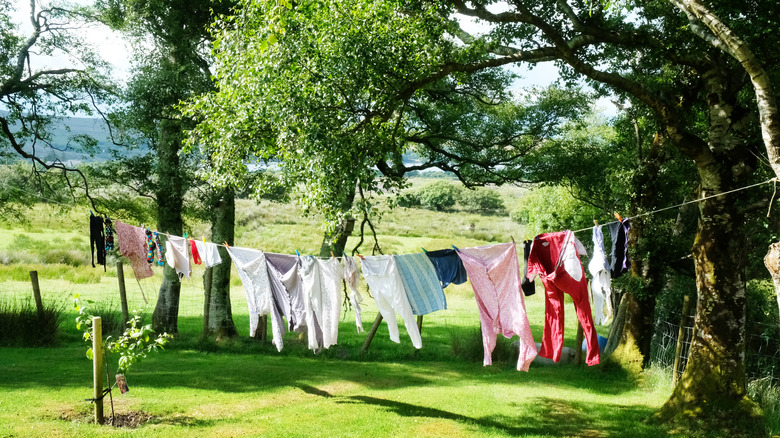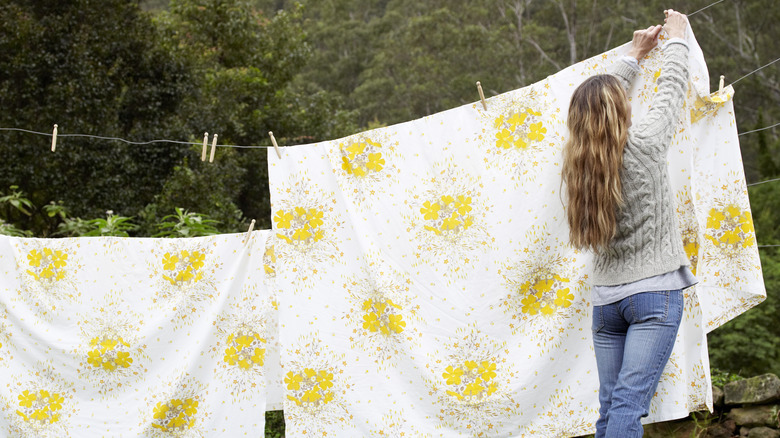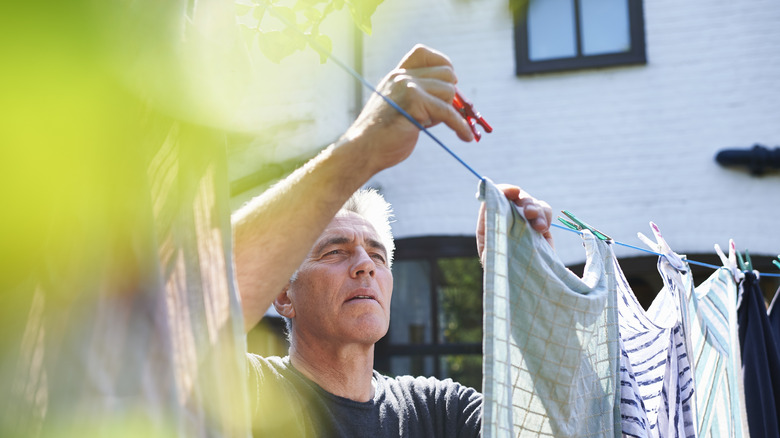The Benefits Of Adding A DIY Clothesline To Your Yard
There are fewer idyllic images than a clothesline strung across a backyard with linens and clothing articles flapping gently in the breeze of a sunny day. Beyond just being romantic to look at, however, drying clothes outside offers a number of benefits to those who adopt them; indeed, the pros are substantial enough that you may be tempted to fashion your own DIY clothesline soon. Among the many benefits of a clothesline are environmental, financial, and hygienic, to name just a few. Added to these perks is the sheer affordability of a clothesline, making one a viable addition to anyone's home.
Clotheslines are some of the oldest drying mechanisms in the world, making their formal advent into the collective consciousness in the early 1800s, some scholars believe. Unlike more archaic forms of drying clothes (think primitive humans drying their laundry on riverside boulders), clotheslines were revolutionary as they lifted wet laundry off the ground and increased airflow, thus speeding up drying times.
Advantages of a clotheline
We humans are always looking for better ways of doing things; while the innovations offered by electrical laundry appliances have their place, sometimes simpler is better. The initial hook that will capture most people's attention is the cost-saving potential of a clothesline. These simple devices eliminate the need for extra energy costs, as you get to harness natural resources like the wind and the sunlight to dry your clothes. The savings to be enjoyed are not chump change either; depending on how much laundry you do, you could save up to 20% on your utility costs by embracing a clothesline. Additionally, if you love using a clothesline (and if your lifestyle permits it), you could ditch your dryer altogether and save on the cost of maintaining such an appliance.
There are also real benefits for your laundry when using a clothesline. Laundry that is hung outside on a clothesline will be incredibly fresh, thanks to the fresh air circulating around it. The sunlight that line-dried clothes are exposed to will also help to "https://www.housedigest.com/1384733/brighten-whites-naturally-without-bleach-laundry-trick/">whiten them naturally without bleach. If you're looking to sanitize bedsheets or other items, you'll also get antimicrobial effects when using a clothesline.
A few clothesline considerations
"https://www.housedigest.com/1512989/diy-laundry-fabric-softener-vinegar-baking-soda/">As convenient as electric clothing dryers are, they can be hard on laundry: constant exposure to heat and tumbling can result in accelerated wearing out of clothes (consider how many articles of clothing you own that have "hang dry" as part of their care instructions). If you're seeking to get the most out of your clothes, remember that a clothesline can also help improve the longevity of your items.
Clotheslines deliver a holistic solution to drying your laundry that is superior in many arenas, but a few caveats remain. Depending on where you live, clotheslines may be more or less efficient. Cloudy, dreary, or rainy places with limited sunlight will make using a clothesline more difficult, as the efficiency of a clothesline depends on good weather. Related to this point is that on rainy days, it might be necessary to fall back on your indoor dryer (or risk being frustrated by rain-soaked items). Some complain that clotheslines lead to rough-feeling clothes. This is because many people use fabric softener sheets or wool balls during the drying cycle and might miss out on this additive when line-drying clothes. If you find this to be a problem, remember to add white vinegar or another "https://www.housedigest.com/1512989/diy-laundry-fabric-softener-vinegar-baking-soda/">homemade fabric softener to the next wash cycle. You can also toss extremely crunchy items (like jeans) into the dryer on tumble mode to soften them. With the proper preparation and circumstances, adding a clothesline to your life could be a big win.


